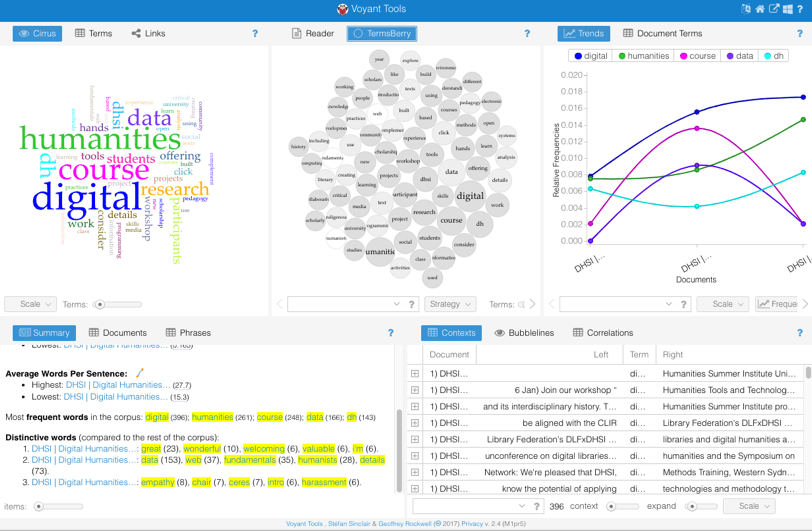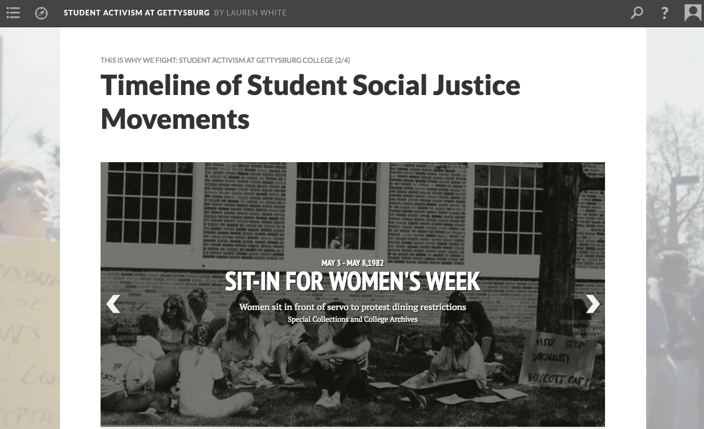As a librarian who is passionate about languages, literature, pedagogy, and research, I’m curious about how technology assists their study and practice. I’m also confident that technological innovation needs the critical and constructive perspectives of humanities students and scholars. For these reasons, I wanted to become more proficient in a field that delves into many of these interests and concerns: digital humanities (DH). So, I decided to attend the Digital Humanities Summer Institute (or DHSI) at the University of Victoria in British Columbia.
DHSI has been held at the University of Victoria for almost two decades. It’s evolved over time into a 2-week institute where participants take intensive, week-long classes in a particular area of digital humanities. There are also preconference sessions, conversational sessions, and daily colloquia. Longtime practitioners in DH teach, learn, and share ideas and projects alongside professors, librarians, archivists, graduate students, independent scholars, and journalists from all over the world — some who have been using digital tools and methods in their work for a long time, and others, like me, who are just starting out.
I arrived at DHSI with all of the anticipation, excitement, and nervousness that new learning adventures often bring. I soon found that I had nothing to be apprehensive about because DHSI and the University of Victoria provided a welcoming environment. And, any lingering homesickness that I might have been harboring was quickly abated by an assigned reading which mentioned Roberto Busa, a Jesuit priest and librarian who is often cited as the father of digital humanities. I learned that in the late 1940s, Busa asked IBM to assist him with work on the Index Thomisticus, a tool that made Thomas Aquinas’ corpus searchable. This project was a multi-year endeavor and a great example of the Jesuit influence on DH.
Digital tools are built a lot faster than they were in the 1940s. I learned that common DH methods and projects – such as text analysis, data visualization, mapping, and online publishing – may have any number of different tools, both open-source and proprietary, that scholars use to help them ask and answer new questions. One tool that I particularly liked experimenting with was Voyant – a simple and easy-to-learn open source text analysis and data visualization tool.

Playing around and experimenting with different tools was fun, but a common refrain at DHSI was to be reflective and discerning about the use of these tools and their value to one’s particular research or projects. Course facilitators stressed that vetting tools is an important part of their research process.
As a result of the reflection and learning I was encouraged to do at DHSI, my own notion of and interests in digital humanities expanded considerably. I began conceiving of my own DH less in terms of tools and methods like text analysis, and more in terms of creating digital collections in collaboration with community stakeholders.
For example, how can I creatively use, remix, learn, and tell new stories or ask new questions with our existing library collections, both digital and analog? And how can I enhance these stories with multimodal learning and experience – by including aspects such as 3D replicas, sound, maps, and timelines? How can I involve our campus community in this endeavor? And, in keeping with our USF mission of changing the world from here, how do projects like digital exhibits make scholarship accessible and in service to communities outside of academia?
Furthermore, the two intensive classes that I took at DHSI – Critical Pedagogy and Digital Praxis in the Humanities (facilitated by Robin DeRosa and Chris Friend) and Models for DH at Liberal Art Colleges and Four Year Institutions (facilitated by Angel Nieves and Janet Simon) – encouraged participants to integrate student learning early and often in our DH work. In one of my classes, we talked about creating an online, interactive and open source Early American English literature textbook with and for undergraduates.
I also heard about student DH summer fellowships, where students earned summer course credit for conceiving of and creating a DH project in collaboration with faculty mentors. For example: Lauren White, a junior at Gettysburg College and a double major in Environmental Studies and English, worked with Musselman Library as a Digital Scholarship Summer Fellow. Using a platform called Scalar and material curated from her institution’s special collections and archives, White created This is Why We Fight, an interactive timeline of student-led social justice movements at Gettysburg College.

Here is another example of a project that I enjoyed learning about: Undergraduate and graduate students and their professor, Dr. Kristin Allukian at the University of South Florida, used a platform called Omeka to create, in consultation with a librarian, a searchable, cataloged digital collection or database of suffrage postcards, and are using this database alongside historical research to analyze and ask questions about these artifacts and their historical context. Their work is online and available for anyone to browse or use.
With examples like these as inspiration, I returned home from DHSI thinking about related projects I’ve worked on in the past, and those I’d like to work on in the future. I’m still interested in text mining and analysis (particularly after reading this article). But as a result of attending DHSI, I’m interested in so much more now.
My time at DHSI inspired me to consider the rich content in the USF library’s digital collections and how I might embark on a digital project or exhibit with students that curates content from and uses these collections to tell a story like the one Lauren White tells in “This is Why We Fight.” For example, what stories might be told with the library’s newly digitized collection of USF Foghorn newspapers? I’ve also been browsing Calisphere’s collectionsand digital exhibits for examples of exhibitions and ideas. Calisphere is a project of the California Digital Library, into which all ten University of California campuses, in addition to other California universities, libraries, and cultural institutions (including USF) have contributed digitized content. Last year, Calisphere began accepting proposals for exhibits, or “curated sets of items with scholarly interpretation that contribute to historical understanding.”
My two week immersion at DHSI was, of course, not nearly enough for me to become fluent in digital humanities. As many people I met at the institute suggested, however: it’s OK to start small, and learn from each other as we embark on this work. Collaboration and continued professional development is key. I now feel comfortable tapping the community from DHSI for help in this endeavor. A few librarians at Gleeson Library | Geschke Center also have interests in digital humanities and digital scholarship. I know our Digitization Librarian, Jessica Lu, our scholarly communications librarian Charlotte Roh, and others are excited to discuss the possibilities of DH at the University of San Francisco, too.
Colette Hayes is an assistant librarian at Gleeson Library | Geschke Center.